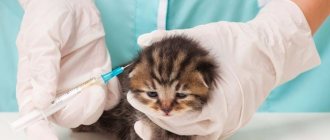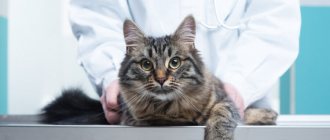Since we and our animals have to live in a world where danger lurks at every step, it is not surprising that we want to somehow protect ourselves from it, and protect our pets.
One of the deadly dangers is diseases transmitted by airborne droplets or other means from one warm-blooded creature to another, and having a severe course and often death. To help humanity, and then animals living near humans, protection was invented in the form of vaccines - medical preparations designed to develop immunity to infectious diseases, made from weakened or killed microorganisms. Currently, many vaccines have been developed against various infectious diseases , and numerous manufacturing companies vying with each other to offer their own drugs. But my goal is to tell you about the basic rules of vaccination, and not to advertise the manufacturer of a particular vaccine.
What conditions of detention do sphinxes require?
Canadian Sphynxes do not require “greenhouse” or any special conditions of detention, but some features should certainly be taken into account.
Despite their hairlessness, Sphynx cats tolerate cool weather well, and prefer to sleep in a closed or fenced place (under a blanket, in a cat house, in a bed with high sides). Like all cats, Sphynxes are contraindicated in drafts, sudden temperature changes and excessive exposure to sunlight. The Canadian Sphynxes need the sun, but you should not abuse it - it can be dangerous for the health of the animal, as they can get sunburn. If your pet likes to observe life from the outside, lay rugs on the windowsills that will help protect them from hypothermia during the cold season.
Proper maintenance of sphinxes also involves entertainment and communication. Without games, the Canadian Sphynx can begin to play pranks, getting rid of boredom, and without communication, it becomes melancholy, becomes withdrawn, and sometimes aggressive.
In Canadian Sphynxes, due to the lack of hair, sweat is secreted all over the body, and when it dries, it gives a light brownish tint not only to the cat’s skin, but also to those things that the cat touches. Therefore, it is not recommended to leave items of clothing in places where cats can sit or lie (on beds, chair seats, armchairs, etc.).
Any tray for the Canadian Sphynx will do, but the sides must match the size of the cat. The bed, bowls and tray should be kept clean to prevent the development of pathogenic bacteria.
A tray of any configuration and type, care products, a separate sleeping place, bowls (2 or more pieces), toys, a scratching post, food, a harness (for walking cats), a carrier, a first aid kit with first aid medications, clothes, sunscreen (specially designed for hairless animals).
Give your pet a separate place in the house where he can spend time and relax alone. The best location for a cat bed is away from hot radiators, drafts and doors.
Make sure that the animal is constantly warm and not overcooled, otherwise it may catch a cold. If the apartment is cool, you can wear special clothes on the sphinx.
Possible complications after vaccination in a kitten
Each animal's body reacts differently to the vaccine. Some pets may develop the following side effects:
- apathy and loss of appetite;
- refusal of water and even your favorite food;
- increased drowsiness;
- swelling and induration at the injection site;
- increased body temperature;
- convulsive conditions;
- pleurisy and encephalitis;
- pain at the injection site;
- change in fur color at the injection site and even hair loss;
- some changes in behavior.
Important: in very rare cases, a kitten’s body does not develop immunity to infections and viruses even after vaccination, but this is an individual characteristic of the animal.
As a rule, all non-dangerous side effects go away on their own within 1-4 days after vaccination or require symptomatic treatment. For example, allergic reactions are eliminated with antihistamines. In any case, if side effects occur, you should consult your doctor for advice.
Is it possible to walk with the Canadian Sphynx on the street?
It is possible, but before deciding on this event, you need to get a full range of vaccinations for “street” cats, purchase a harness and teach your Sphynx to walk in it.
The Sphynx should be accustomed to the street gradually, preferably in early childhood. Exposure to the world late can lead to a lot of stress. Walking should only be done in the warm season. Extended exposure to the sun can lead to overheating or burns. Animals visiting the street need to be given anthelmintic drugs more often (once a quarter).
By Nickolas Titkov
Mono-vaccines for cats: composition and application
Monovalent vaccines provide protection against only one disease - rabies, rhinotracheitis, plague, etc. Such vaccines contain inactivated or live viruses that develop stable immunity to a specific antigen.
It is advisable to vaccinate kittens against rabies with a single vaccine, since such a vaccination has an aggressive effect on the young body, and it is not recommended to combine it with others. Which type of mono-rabies vaccine is best to choose? How do drugs from different manufacturers differ?
For rabies (Nobivak Rabies, Biocan R, Rabifel, Rabikan, Rabizin, Rabigen Mono)
Rabies is the most dangerous disease that a cat can get. In 100% of cases, an unvaccinated animal dies. In addition, an infected pet poses a direct threat to family members. To prevent a disastrous outcome, the kitten must be vaccinated regularly and in a timely manner.
For rabies, you can choose the following mono-vaccines:
- Nobivak Rabies – develops lasting immunity after 3 weeks, combined with other drugs from this manufacturer;
- Rabizin - a French drug available in the form of a suspension, contains an inactivated virus;
- Rabican is a dry vaccine that must be diluted with distilled water before administration.
There are other analogues of the listed mono-vaccines: Biocan R, Rabifel, Rabigen Mono, etc. The drugs are administered subcutaneously or intramuscularly, at the discretion of the doctor.
Revaccination against rabies with monovaccines is carried out annually. An exception is the drug Nobivak Rabies, which produces immunity for 3 years.
Other mono-vaccines (Vakderm-F, Nobivak Bb, Biokan L, Polivak-TM, Chlamikon)
Monovalent vaccines are used not only to prevent rabies in domestic animals. In veterinary pharmacies you can purchase drugs to protect against other diseases:
- Vakderm F – prevention and treatment of dermatophytosis;
- Nobivac Bb – live vaccine against bordetellosis;
- Biocan L – plague prevention;
- Polivak-TM – protection against dermatomycosis;
- Chlamycon is an inactivated vaccine against chlamydia.
How to accustom a Sphynx kitten to a scratching post and stop it from scratching furniture?
You can't force a cat to do anything it doesn't want to do. It is also very difficult to get her to stop doing what she likes. Therefore, when training to use a scratching post, it is necessary to redirect the kitten’s/cat’s desires in the right direction. Cats do not understand physical punishment, so hitting them is useless. Hitting will only worsen your relationship, and the cat will begin to avoid you. Cats have excellent memories and sometimes hold grudges for a long time.
Before you start training a scratching post, you should know that cats try their claws on anything and everything for some reason: - marking territory (scratching is an innate territorial instinct), - exercise (scratching serves to keep the cat in physical shape), - for pure pleasure, - changing the dead top layer of the sheath growing on top of the claw (thanks to this, cats' claws are always sharp).
Now you need to choose the right scratching post. Its height should be such that the cat can fully extend its body with its paws (not shorter than 70 cm). Pillar scratching posts are considered the best. When choosing, pay attention to the stability and safety of the scratching post. If she falls and scares the cat, the animal will most likely never approach her again.
The material from which the scratching post is made should have a rough surface that can be torn into pieces. Jute material is ideal for this (not rope!). You can make your own vertical scratching post from an old carpet. Turn it over and attach it to the wall or an old scratching post. Ready!
To teach your kitten to scratch the scratching post, start playing next to it. Try to have the kitten scratch it while playing. Praise the kitten if it behaves the way you want it to. Never grab your cat's paws and forcefully scratch the scratching post with them; this is unlikely to work. If your kitten scratches at an inappropriate object, move him to the scratching post and direct his attention to it.
The scratching post should be placed where family members visit most often. Sometimes you may need not one, but several scratching posts (in those places where the kitten likes to scratch furniture and things). To attract attention, you can rub dried catnip leaves into the scratching post. You can attach a toy on a string to the scratching post.
If the kitten does not stop tearing up the furniture, then you can try to protect it with double-sided tape, and also spray it with citrus oil (cats really don’t like this smell). You may need to thoroughly wash the areas where your kitten has started scratching the furniture (removing his smell). Pet stores sell special products to eliminate animal odors.
We suggest you familiarize yourself with the behavior of a cat the day before giving birth. Cat's behavior before giving birth: signs you can't miss. Normal pregnancy in a cat
If your cat still continues to scratch the furniture, try spraying it with a water gun or spray bottle. Another option is a loud whistle or sudden loud noise. You can set a trap, such as a cup of water or something similar. As soon as the kitten begins to tear up the furniture, water is poured on it or something falls noisily nearby.
How many years do Canadian Sphynx cats live?
The general rule is to consider your comfort level. If you are comfortable enough in the house to walk around naked, then Sphynx cats are usually comfortable too. If you are wrapped in a sweater or lying under a blanket to keep warm, the sphinx will be lying next to you :). During the year, the temperature in the apartment/house should be between 20-25°C.
If the Sphynx really gets cold, he will look for a place to warm up, for example, on a TV or computer monitor, under a blanket or bedspread, on a windowsill in the sun, near a radiator or heater, etc. In pet stores you can buy heated beds, which are very Sphynxes like them.
In the summer, when it’s hot, you should think carefully before turning on the air conditioning, as the Sphynx can easily catch a cold.
Depending on the living conditions of the Canadian Sphynxes, their life expectancy is approximately 10-17 years. The average age is considered to be 13-15 years. According to Cat Fancy Magazine (March 1997), Granpa Rexs Allen, a Sphynx-Devon Rex hybrid, lived to be about 30 years old.
What diseases are Sphynx cats susceptible to?
Modern Canadian Sphynxes have good health, although quite often cats of this breed are susceptible to various infections. However, timely vaccination significantly reduces the risk of colds and some other diseases.
Adult Canadian Sphynxes rarely get sick, but in the breed (depending on the breed line) there are not only hereditary diseases, but also a genetic predisposition to certain diseases: shortening of the lower jaw (otherwise known as “carp bite”, undershot); congenital entropion of the eyelids; microphthalmos (congenital malformation of the eye);
acne; skin vasculitis (inflammation of the blood vessels of the dermis and subcutaneous tissue); softening of the last caudal vertebra; seasonal dermatitis; hyperplasia and breast cyst (excessively rapid growth of breast tissue); congenital underdevelopment of the thymus (the disease leads to increased sensitivity to infectious diseases - primarily viral and fungal);
glandular-cystic degeneration of the mammary gland; gingival hyperplasia (uncontrolled pathological proliferation of gingival tissue cells); hypertrophic cardiomyopathy (this breed of cats has a high percentage of development of the disease); mitral valve dysplasia; skin cancer (if cats are exposed to direct sunlight for long periods of time);
Interestingly, due to their hairlessness, the skin of the Canadian Sphynx is strong and it is very difficult to pierce it with a syringe needle in some places.
Due to their lack of fur, hairless cats are prone to sunburn. Therefore, sphinxes, especially before going outside, should be smeared with sunscreen designed specifically for hairless animals. Human creams are not suitable for this purpose! Pay special attention to the tips of your ears and the bridge of your nose.
How to care for Sphynxes
Due to the nature of their skin, sphinxes require special care. Their skin is somewhat similar to human skin; for example, they, like us, can burn in the sun. These hairless cats sweat and their skin produces oil. Therefore, they need to be bathed once or twice a week and regularly wiped with a soft, damp towel to remove skin discharge.
Ear cleaning is another mandatory procedure when caring for hairless cats. For this it is better to use special lotions. The eyes also need to be regularly cleaned of secretions that accumulate in the corners.
Sphynxes also need to have their claws trimmed regularly. This can be done at home or in a veterinary clinic.
Complex vaccines: indications and use
A comprehensive vaccination allows your pet to develop immunity to several dangerous diseases at once. Its advantages over mono-vaccines are obvious - the kitten does not have to be injected several times, the immune system develops the necessary protection against diseases after one injection.
Polyvaccines are administered according to the following scheme: primary vaccination - at 2-3 months, second - a month later, subsequent vaccinations - for life with an interval of 1 year. Vaccination against infectious peritonitis is usually not included in comprehensive protection; vaccination against this disease is carried out at the age of 4 months.
Where is it better to vaccinate – at home or in a veterinary clinic? It is better to refuse self-vaccination, since an incorrectly administered injection or at the wrong time can affect the pet’s health. An experienced veterinarian will tell you when and how best to vaccinate the animal, choose the optimal time and the correct dosage of the drug. Which polyvaccines should I choose for vaccination? What are their features and differences among themselves?
Felocel 4, Nobivak Forcat, Multifel-4, Purevax RCPCh, Felovax-4
Live vaccines “Phelocel 4” and “Nobivak Forcat” form an immune response in your pet to 4 dangerous pathogens at once - plague, rhinotracheitis, calicivirus infection and chlamydia. The drugs Multifel-4, Purevax RCPCh and Felovax-4 are inactivated vaccines and protect against the same diseases.
Live vaccines form more powerful immunity in a pet after double vaccination, but have one drawback - in weakened animals, the body may not be able to cope with the load. Inactivated drugs are more gentle. They also form a good immune response, but provide a less lasting protective effect.
Felocel CVR, Nobivak Tricat trio, Purevax RCP, Feligen CRP
Injections of the drugs “Felocel CVR”, “Nobivak Trikat trio”, “Purevax RCP”, “Feligen CRP” are aimed at triple protection - against viral rhinotracheitis, plague and calicivirus. Vaccines form stable immunity in a pet 10–20 days after double vaccination, the effect lasts for a year. These vaccines do not provide immunity against chlamydial infection.
Quadricat, Biofel PCHR
The French drug “Quadricat” forms comprehensive protection for your pet against rabies, herpes simplex virus, calicivirus and panleukopenia. Contains inactivated and attenuated strains of viruses. The effect occurs already on the 14th day after the first injection, and is reintroduced a year later.
Biofel PCHR produced in the Czech Republic has a similar effect. This drug is administered twice with an interval of 3–4 weeks. The duration of action is 1 year, after which revaccination is indicated.
Biofel PCH
The drug “Biofel PCH” protects the kitten’s body from panleukopenia, calicivirus infection and the causative agent of the herpes virus. It is administered twice with an interval of 3–4 weeks. Persistent immunity is formed 2 months after revaccination and persists for 12 months. The vaccine contains inactivated strains of viruses and is safe for the health of young animals.
Do Sphynx cats need to be vaccinated if they do not go outside?
We all, of course, want our pet to live happily ever after. After all, a cat is like a small child. She can't tell us where or what or how much it hurts. Therefore, the concern for her health lies entirely on our shoulders, the shoulders and the owners.
There are many measures you can take to protect your cat from random illnesses. For example, protect her from all kinds of accidental contacts, keep her warm and make sure she doesn’t eat anything harmful. All this is correct, just the goth part. Do not forget about timely vaccination of your cat.
We invite you to familiarize yourself with Dogs and cats that do not cause allergies in people
The first injections should be given to a kitten between 1.5 and 4 months of age. Before this, it is necessary to show him to the veterinarian so that he can assess the general condition of the cat, since vaccinations can only be given to a healthy, not weakened cat.
Quadricat is a combined quadrivalent vaccine against rabies, panleukopenia and feline respiratory viruses (herpes virus, qualifyi virus).
Leucorifelin (Rhone-Merrier, France) is a combined trivalent vaccine against infectious panleukopenia and respiratory disorders caused by feline herpes and caliciviruses.
The Canadian Sphynx generally tolerates vaccinations well, if, of course, they are done correctly, with all precautions. We especially draw your attention to the fact that it is mandatory to have the necessary vaccinations for cats. Don’t rely on chance. Take your cat to the veterinarian for examination in a timely manner and your pet will delight you with its excellent health, activity and good mood for many years.
About vaccinations. is it necessary?
There are people who, having bought a Sphynx kitten, reason very simply: why vaccinate if the cat sits at home and doesn’t go anywhere. Do not forget that it is easier to prevent a disease than to treat it later, but it will take a long time and require a lot of money, and the result is not always positive. It is very easy to bring the infection on shoes from the street.
Most cat owners visit their veterinarian once a year for regular preventative vaccinations.
Treat this visit like your cat's annual checkup and ask your veterinarian to examine her thoroughly. A significant proportion of diseases detected at an early stage are treatable. Currently, cats are immunized against many diseases. Consult your veterinarian which vaccine is right for your animal.
Some cats, like people, feel slightly unwell after vaccinations and may even have an upset stomach for a day or two, but there is no cause for concern as long as this does not last more than 48 hours. It is important to protect your pet from as many known diseases as possible.
When purchasing a cat, you should make sure that it is up to date on its vaccinations, otherwise get them done as soon as possible. If you already have other cats, place the new pet separately for 7-10 days, since after vaccination it can be a source of the virus.
To vaccinate Sphynx kittens, I use imported vaccines: Nobivas Tricat, Quadricat. Leucorifelin. Fel-O-Vax.
Rabies vaccination is required. We use Nobivac Rabies.
10 days before vaccination, deworming is MANDATORY!
Kittens should be vaccinated regularly to protect against infectious diseases: upper respiratory tract infection, viral rhinotracheitis, panleukopenia, rabies and leukemia. Kittens become susceptible to these infections when they lose the protective antibodies they receive in colostrum. The duration of action of maternal antibodies is highly individual and ranges from 3 to 15 weeks. The initial series of vaccinations consists of a combination of vaccines and is given at 9-10 weeks of age, followed by a booster dose at 12-13 weeks.
Vaccination against ringworm.
A vaccine with inactivated fungi of the genus Microsporum protects against ringworm. This vaccine is given to cats 4 months of age and older to both prevent and treat this disease. Revaccination is carried out after 10-14 days. Then annual revaccination is recommended.
Kittens should be regularly checked for gastrointestinal parasites and dewormed. Fecal testing for worm eggs should be performed starting at three weeks of age and then annually in adult cats. Health problems caused by parasite infection depend on the type of worms and the degree of infection. Anemia, vomiting, diarrhea, cough, hair loss, the presence of white glens around the anus, similar to grains of rice, indicates infection with worms.
Deworming includes direct therapy with appropriate anthelmintic drugs, which must be repeated after 2-4 weeks to completely destroy the next generation of parasites.
Sphynxes are specific in their care, unlike other cat breeds. There is one big plus - there is no wool and there are no problems associated with its presence. But there are some nuances in caring for a Donchak, knowing them, your naked miracle will always look gorgeous.
ü The Don Sphynx cat is very thermophilic, so it is necessary to keep it in a warm room.
ü Due to increased heat transfer, the Don Sphynx consumes a slightly larger amount of food than other cats.
ü Due to the absence of eyelashes on the eyes, mucus may accumulate in the conjunctival sacs, which must be removed with clean cotton wool or a cloth.
We invite you to familiarize yourself with what to feed a Jack Russell puppy menu by age
ü Bathing can be replaced by drying.
ü Estrus in cats occurs relatively rarely, and they are rarely “marked.”
ü There is no characteristic odor, wool does not remain on things.
ü People who are allergic to cat fur have less frequent reactions to the presence of Don Sphynxes.
ü Kittens are quite easily toilet trained.
ü Cats are touchy (but not vindictive) and affectionate, which requires the owner to pay more attention to them.
Sphinxes are very sensitive creatures. Their delicate skin requires regular and careful care from the very eyes to the tip of the tail. The whole complex of measures consists of two main points: regularly bathing the cat (about once every two weeks) and wiping the tail with lotion. This is due to the physiological characteristics of sphinxes.
Hairless cats secrete a specific brown substance to protect their skin from external factors. It forms a kind of coating on the body of the sphinx and accumulates in the folds of its skin. The balder the cat, the more prominent it is, which means the percentage of presence of the protective substance is higher. However, an excess of plaque may indicate a cat’s poor nutrition, lack of hygiene procedures, or indicates health problems.
The Sphynx cat is bald and there is no point in buying him the same shampoos as for fluffy breeds. You can use baby wash products that do not contain fragrances or dyes (baby shampoos with Ph = 5.5 that are not irritating to the eyes, for example, Johnson's baby). If the substance secreted by sphinxes is difficult to wash off with regular shampoo, apply baby cosmetic milk to its skin. Gently massage the skin so that the plaque begins to dissolve and rinse thoroughly with water.
We recommend that you cut your pet’s nails before starting bathing in order to avoid scratches during the bathing process (as you know, cats do not always correctly interpret the good intentions of their owners and do their best to avoid the bathing procedure).
After bathing, you need to dry the Sphynx well with a towel so that it does not freeze. It is better to use a large bath towel.
“Legs, wings, the main thing is the Tail!”, says the cartoon of almost the same name. And for the sphinx this phrase has significant meaning. Starting from puberty, the tail of the Don Chak becomes covered with “black dots”. Everything is like people! This means that it is necessary to wipe with alcohol-free lotions for problem skin (we recommend acne gel "ACNE") to cleanse clogged sebaceous glands.
In summer, sphinxes love to bask in the sun. At this time, their skin becomes tan, which leads to a slight change in color. Just like humans, it is not advisable for hairless cats to stay in direct sunlight for long periods of time. It's bad for your health. Therefore, keep your pet from frequent sunbathing.
1. Prepare everything you need for swimming. Shampoo, large towel.
2. Fill the bathtub or sink with warm water. The water should be approximately 36-38 degrees. It is advisable to put a rubber mat or terry towel on the bottom so that our dirty little one does not slip. Place the kitten there and wet its skin well with water. The water level is no higher than your chest.
Don't shower your cat - they don't like it. Water from a ladle or from your palm. After this, apply shampoo in an even layer. Particularly dirty areas should be rubbed with a washcloth or sponge.
Try to keep water out of your eyes and ears. Treat your cat firmly but gently. Keep in mind that she may try to escape and accidentally bite or scratch you. To avoid this, we repeat: accustom your animal to this kind of procedures from childhood. To calm your cat, talk to it.
Rinse the kitten with plenty of water until all remaining shampoo is removed. After removing him from the bath and drying him, wrap him in a large towel. You can also blot the animal with paper towels; they absorb very well.
Then it is better to hide the kitten under a blanket until it is completely dry.
Sphynx ears require regular care. They must be constantly inspected and cleaned of accumulated sulfur matter. Thick discharge quickly accumulates in the Sphynx's ears. They do not bring him any particular inconvenience, but from the point of view of the animal’s health, you should take care of the cleanliness of his ears, as if you were your own.
Features of the first vaccination
To immunize kittens, two types of vaccines are used: live and dead (inactivated). Vaccines containing live virus form more durable and stronger immunity, but can sometimes trigger the occurrence of a certain disease.
The inactivated drug gives a less stable protective reaction, but can cause complications in the cat’s liver and kidneys. Despite the possible consequences, a dead vaccine is more easily tolerated by the animal's body. For particularly dangerous infections, such as rabies, only inactivated vaccines are used.
Before the first vaccination, it is important to check the health of your furry pet. It is necessary to exclude the possibility of contact between a kitten and a sick relative. If, shortly before vaccination, the baby met a cat with obvious signs of an infectious or viral disease, vaccination is postponed for 14 days. The exemption from vaccinations after operations is 3-4 weeks.
Replacing baby teeth with permanent ones has long been no longer considered a contraindication to vaccination, like other physiological conditions.
The first vaccination for kittens is given with polyvalent vaccines. As a rule, they act against rhinotracheitis, panleukopenia and calicivirus, and sometimes contain a component against chlamydia. After 21 days, a second vaccination (re-vaccination) is carried out. The animal is then immunized every 12 months throughout its life, although some imported vaccines after the age of three are recommended to be repeated every 2-3 years.
After the first vaccination, the kitten may slightly reduce activity, become a little less playful, and eat a little less than usual. If the pet is lethargic, sleepy, does not show interest in games and food, does not eat for more than a day, or has a fever, he is urgently shown to a veterinarian.
A mandatory preventive measure for every animal, regardless of its age category, is a rabies vaccination. If a kitten visits the street, communicates with relatives (at exhibitions, in pet hotels), and it is also planned to export the animal abroad, vaccination against rabies must be carried out from 3 months of age.
What do sphinxes get sick of?
Hairless cats can develop infectious, colds and skin diseases (acne, dermatitis), eye problems, food allergies and other difficulties. And overfeeding can lead to obesity.
As for congenital diseases, sphinxes have a shortened lower jaw (the so-called carp bite), defects in the development of the spine (curvature of the tail), microphthalmos (problems with the development of the eyeball) and more.
To avoid possible problems, carefully monitor your pet's condition and pay attention to any changes. For example, due to poor nutrition, skin discharge can become quite profuse. At the first signs of health problems, it is better to immediately contact a veterinarian.











